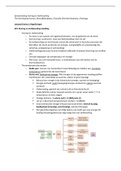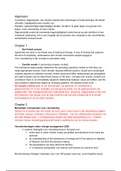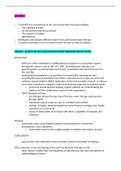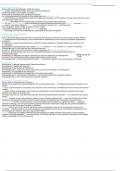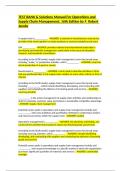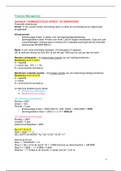Chapter 1: Applied Psychology: Designing interventions for psychological problems ........................... 4
~ Behaviourism/science of behaviour ................................................................................................ 4
The cognitive revolution in psychology .............................................................................................. 4
~ History of applied psychology .......................................................................................................... 5
Hugo Munsterberg describes two approaches expedient for the application of psychological
knowledge ........................................................................................................................................... 6
~ In Dutch social science literature there is often a distinction between two cycles......................... 6
~ Types of psychological research....................................................................................................... 7
~ Core activities of human problem-solving ....................................................................................... 7
~ Experts in problem-solving can be identified by a number of key features according to Chi,
Glaser and Farr: ................................................................................................................................... 8
~ In the field of educational problem-solving or instructional design, a model has been developed
which will help explain the underlying logic of the design approach in psychology .......................... 8
~ Technical design ............................................................................................................................... 9
~ Psychological design, similar to instructional and technical design, is the discipline that
encompasses knowledge and skills to systematically develop psychological interventions and
apply them. ....................................................................................................................................... 10
~ For the core activity Analysis, there are many models to determine and control the process. In
health psychology, the PRECEDE model is used. .............................................................................. 11
~ For the core activity Synthesis, the outcomes of the core activity Analysis are used to determine
and design the blueprint for an intervention. .................................................................................. 11
~ For the core activity Construction, sub-domains of psychology are used to help develop an
intervention that the largest possible impact can be achieved........................................................ 11
~ For the core activity Evaluation, test psychology and research methodology are applied to
provide effective methods for the evaluation or impact assessment of an intervention. Validity
and reliability are essential. .............................................................................................................. 11
Chapter 2: Development of interventions using ASCE model .............................................................. 11
~ Analysis: analysing the problem, behavioural analysis, determinants of the problem behaviour 12
~ Synthesis: Determining the goals of an intervention..................................................................... 12
~ Construction ................................................................................................................................... 13
~ Dissemination, adoption, implementation and continuation of the intervention ........................ 13
~ Evaluation....................................................................................................................................... 13
Chapter 3: Analysis of the psychological problem ................................................................................ 14
~ Problem analysis ............................................................................................................................ 14
~ Literature search & identifying appropriate sources ..................................................................... 15
~ There are six guiding questions for the problem analysis. Answering these will make for a clear
problem statement. .......................................................................................................................... 15
, ~ A proper problem analysis will weigh up all pros and cons of different perspectives, which will
also result in a clear problem statement (see also microlecture 1.2). ............................................. 17
~ How to write the problem analysis ................................................................................................ 17
Chapter 4: Analysing the undesired and desired behaviour................................................................. 17
~ Problem behaviour of the at-risk group......................................................................................... 18
~ Environmental influences on the problem behaviour ................................................................... 18
~ Determining the target group of the intervention ........................................................................ 18
~ Determining the desired behaviours of the target group.............................................................. 18
~ Determining the intervention objective ........................................................................................ 19
Chapter 5: Analysis of Behavioural Determinants ................................................................................ 19
~ Explaining behaviour ...................................................................................................................... 19
~ Cognitive determinants of behaviour ............................................................................................ 20
~ Theoretical models in health- and social psychology concerning the cognitive processes
associated with human behaviour .................................................................................................... 20
~ Proximal and distal determinants of behaviour ............................................................................ 23
~ Theory of Planned Behaviour: attitudes, subjective norm and perceived behavioural control
(proximal determinants) ................................................................................................................... 24
~ Accountability: investigating the determinants of behaviour ....................................................... 24
Chapter 6: Synthesis: defining the goals of an intervention ................................................................. 25
~ Before formulating behavioural objectives ................................................................................... 25
~ SMART ............................................................................................................................................ 25
~ Schematic representation: is a tool that formulates change objectives in the form of a table .... 25
~ Beliefs underlying the determinants of Theory of Planned Behaviour.......................................... 26
~ Prerequisites or requirements are environmental changes that could be necessary to make in
order to engender behavioural change. ........................................................................................... 26
Chapter 7: Synthesis: Methods and Strategies ..................................................................................... 28
~ The development of interventions ................................................................................................ 28
~ Methods and Strategies ................................................................................................................. 28
~ Methods ......................................................................................................................................... 28
~ Strategies ....................................................................................................................................... 28
~ Methods & strategies with overlap ............................................................................................... 29
~ The most appropriate methods for an intervention can be classified into three categories:
general methods, methods that produce change in determinants, and methods grounded in
learning theories and other theories of behavioural change. .......................................................... 29
~ General methods for behavioural change ..................................................................................... 29
~ Two ways of processing information according to the Elaboration Likelihood Model ................. 30
~ Methods suitable for changing attitudes ....................................................................................... 30
, ~ Message design: processing limitations......................................................................................... 31
~ Improving message processing: what can be done? ..................................................................... 33
~ Message framing: the LC4MP suggests that messages can be processed in many ways,
depending on the emotional valence. .............................................................................................. 34
~ Personal stories: narratives ........................................................................................................... 34
~ Communicating the message: endorsers ....................................................................................... 34
~ Tailoring is making a product or programme fit to the client’s personal preferences. It will
increase the personal relevance and effectiveness of the message (e.g. by simply using one’s
name). It can also be used to ensure participation. By first screening individuals on patterns and
then selecting the group to participate. ........................................................................................... 35
~ Intervention design and the ASCE model: involvement and accountability.................................. 35
Chapter 9: Construction: Implementation ............................................................................................ 35
~ Diffusion of Innovations Theory (DIT, Rogers) ............................................................................... 36
~ Relative advantage ......................................................................................................................... 36
~ Compatibility with existing values and practices .......................................................................... 36
~ Simplicity and ease of use .............................................................................................................. 36
~ Triability ......................................................................................................................................... 36
~ Observable results ......................................................................................................................... 37
~ Reinvention .................................................................................................................................... 37
~ Peer-to-peer conversations and peer networks ............................................................................ 37
~ Type of adopters ............................................................................................................................ 37
~ After establishing the types of adopters that are best suited for your purposes and you have a
clear idea of the wishes and needs of the target group, the intermediaries for the implementation
plan need to be determined through a stakeholder analysis. ......................................................... 39
~ Stages of the Diffusion of Innovation Theory (DIT) and their applications.................................... 39
~ Potential pitfalls when implementing an intervention ................................................................. 41
~ Circle of accountability................................................................................................................... 41
~ Formulation of the implementation objectives ............................................................................ 41
Chapter 10: Evaluation: Effect and process evaluation ........................................................................ 42
~ Science in evaluation...................................................................................................................... 42
~ Threats to the internal and external validity of research designs ................................................ 42
~ Problem definition, outcomes and outcome line .......................................................................... 43
~ Quasi-experiments: two commonly used designs are the non-equivalent control group and the
interrupted time series. .................................................................................................................... 44
~ Measurements ............................................................................................................................... 44
~ Analysing outcomes and drawing conclusions .............................................................................. 46
~ Elaboration: a form of analysis. Uses third variables .................................................................... 46
, Chapter 1: Applied Psychology: Designing interventions for
psychological problems
Psychology = the science of behaviour and mind
Behaviour refers to observable actions
Mind pertains subjective experiences such as feelings, perceptions, memories, thoughts, motives
and emotions.
~ Behaviourism/science of behaviour
The first attempts to treat psychology as a proper science were made by taking observable
behaviour as the central object of scientific study.
It advocated the use of objective measurements
Central tenet of behaviourism: systematic study of individual or group behaviour is the only way
through which expectations about future behaviour can be made and in turn, formulate
psychological theories.
• Laws of Thorndike are examples of behaviouristic approach (based on studies using
objective measurements)
1. Law of Exercise: relationship between stimulus and response strengthens when the
stimulus is more frequently followed by the same response from and individual (law of
use).
The relationship between a stimulus and a response becomes weaker when a stimulus is
seldomly followed by the same response from an individual (law of disuse).
2. Law of Effect (relatively influential): relationship between stimulus and response
strengthens when the response is rewarded. If punished, the relationship diminishes.
➔ However, once punishment is removed, the undesirable behaviour returns. Studies
conclude that rewarding desirable behaviour is far more powerful.
The cognitive revolution in psychology
Happened after WW2 when psychological researchers considered the behaviourist approach to be
too restricting and focused on gaining insight into underlying mental processes in the mind.
➔ What motives, emotions and thoughts induce an individual to engage in certain
behaviour?
BEHAVIOURISM COGNITIVE PSYCHOLOGY
AIM Describing, understanding and Describing, understanding and
predicting behaviour predicting behaviour
FOCUS Observable behaviour Motives, emotions and
thoughts associated with
behaviour
FORMULATES ASSUMPTIONS Future behaviour/theories Imperceptible processes
ABOUT (mental processes)


